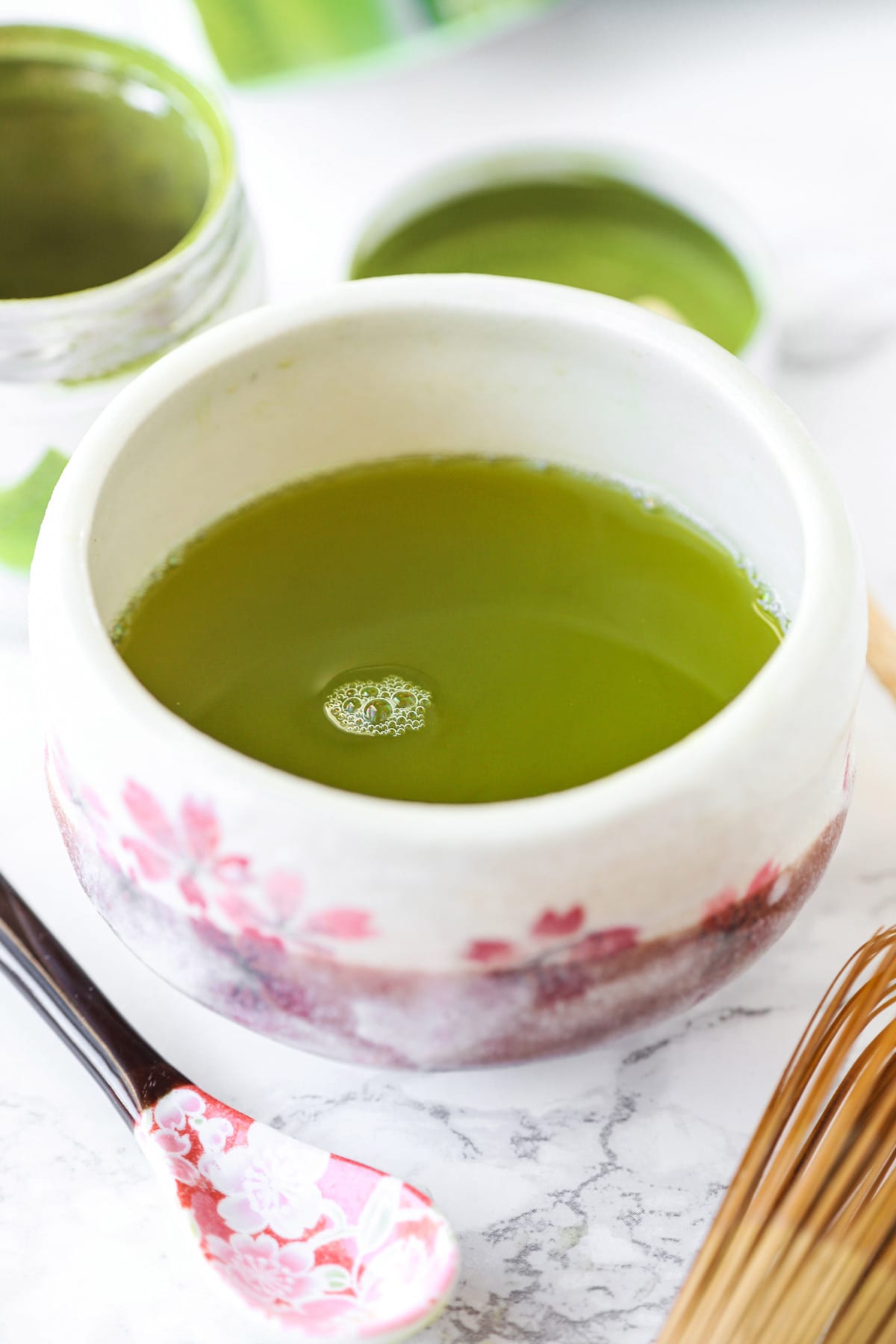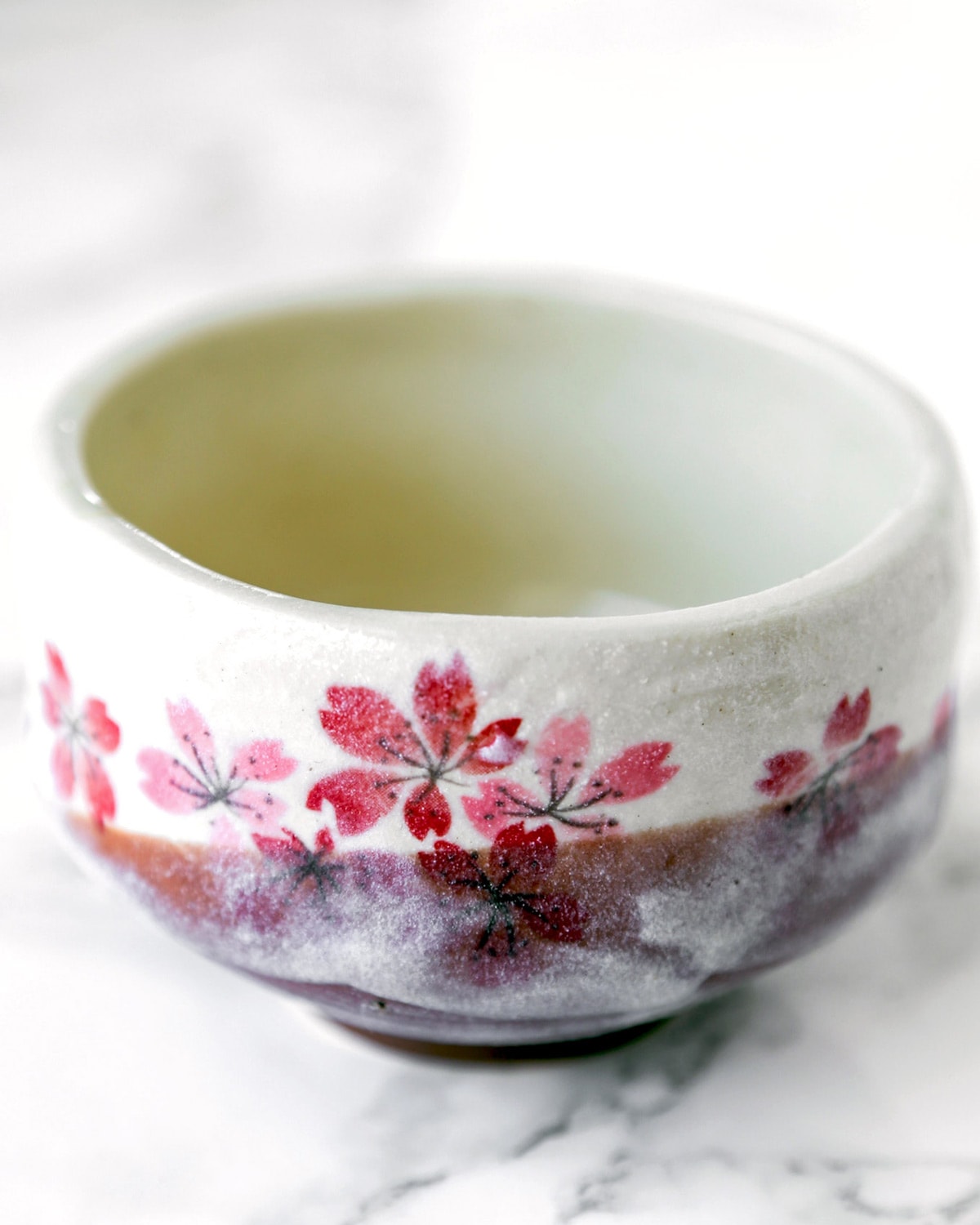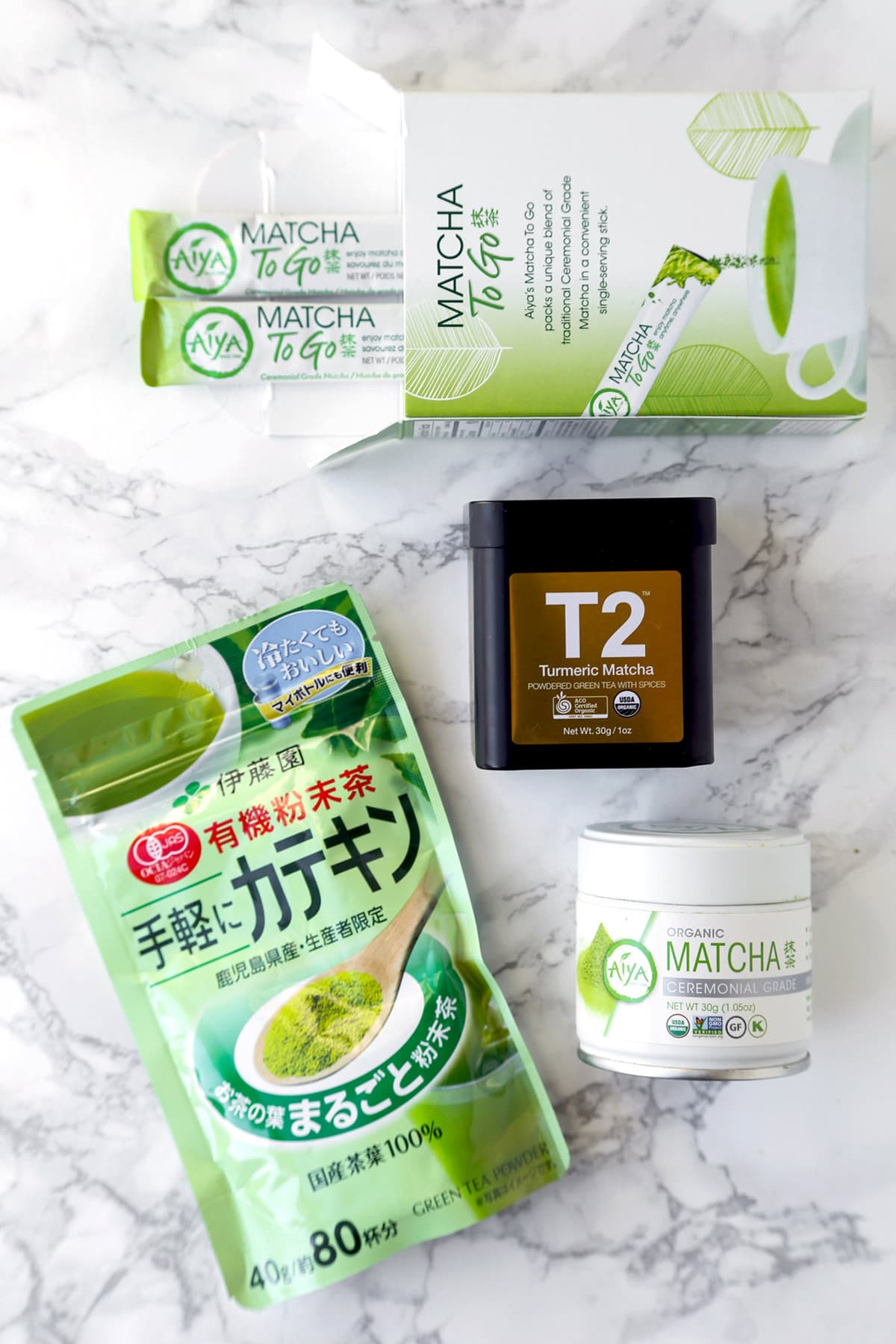Nothing energizes me more than a cup of matcha in the middle of the afternoon. I love its delicate sweet and grassy taste and how it helps me focus better on my work. It’s something I look forward to having every day!

I’m a lover of all things green tea related.
I love the taste of green tea and I also love the whole ceremonial act that comes with it.
I’ve been drinking green tea since I was a little girl and had my first traditional tea ceremony lesson when I was 13 years old. I wish I could share a picture with you just so you could see how excited I was at learning about this old tradition from a tea expert.
Tea Ceremony (Chadō – 茶道茶道)
It was in an old tea house in the Kyushu region and I was wearing a bright orange t-shirt (I do have pictures of it but they are unfortunately at my mother’s house in Japan) with a long ivory skirt, and a Molly Ringwald hairdo from the Pretty in Pink era (except that my hair was jet black).
I knelt down on the tatami mats next to my sensei, who was a sweet older lady, and only using one hand, I turned the tea bowl to the right, then to the left, wiped the rim (I don’t remember the order nor the steps very clearly), and whisked this magical green powder we call matcha.
“Wow, did you see that mom? I’m a pro!” I said to my mother.
She smiled and continued taking pictures.
What’s funny is that I’ve since become a bigger matcha drinker than my mother is. While she prefers the teapot and green tea leaves method, I get more of a kick from the powdered version.
Today I’m going to show you how to make the best cup of matcha in your own kitchen.

What is Matcha?
Matcha (抹茶) is a type of Japanese tea made from green tea leaves that have been ground to a fine powder. It is primarily used as a beverage, served hot or cold, or as a flavoring for baked goods, wagashi confectionery (traditional Japanese desserts) and other types of desserts.
The green tea plants are grown in shaded areas for 3-4 weeks until it’s time to harvest the leaves. The leaves are left to dry, lying flat, and are stone ground to a fine powder.
The process is quite labor intensive since only the finest tea buds are hand picked and the grinding process can take up to an hour to just grind 30g of matcha. If ground too quickly, the leaves lose their aroma from the warmth of the mill stones, so the process takes time and patience.

Accessories Needed to Make Matcha
Chashaku (Tea Scoop)
A chashaku (茶杓, ちゃしゃく) is a thin bamboo stick between 16 cm and 21 cm in length with one end curved, which is used to scoop matcha powder.
What makes this simple bamboo tea scoop so great is that its design make it so you can scoop just the right amount of matcha powder needed per bowl of tea. Japanese tea specialists believe you can get much more accurate measurements with a chashaku than a spoon, resulting in bowls of tea that stay consistent in color and taste.
Do I agree with the tea specialists – do you really need a chashaku to make good matcha?
Absolutely! And I agree that it’s much easier to make consistently delicious bowls of matcha using a tea scoop than a regular spoon. It cuts the whole guessing whether I used too much (I overdid it all the time and would feel queasy) or too little matcha process out of the way.
Of course, you could use a teaspoon to measure your matcha but if you are a regular tea drinker like I am, I urge you to consider getting a chashaku – it’s so much easier and the ritual makes it special, almost meditative.
Chasen (Bamboo Whisk)
A chasen (茶筅,ちゃせん) is a bamboo whisk used to mix the matcha powder and water. It’s an essential accessory to have since matcha powder is different than other types of powdered beverages. Since the powder is made from ground leaves, simply mixing it with water won’t make it dissolve. In fact, it can clump or float if not mixed properly.
Using a chasen helps the powder to mix with the water more easily and it also creates a beautiful foam at the top, making the tea sweeter and milder.
Small Strainer
I’m sure you have noticed that matcha powder can get a little clumpy at times and that chewing on one of those clumps, while sipping your tea, is pretty awful. That’s when a small strainer comes in handy as it gets rid of them. It’s always a good idea to sift the powder before whisking or drinking it.
Matcha Bowl
A matcha bowl is different than a coffee cup or teacup in that it’s wider and more shallow. The reason for that is because green tea is very sensitive to heat and is best enjoyed at the ideal temperature of (180°F / 80°C). And it also makes whisking easier because it has more surface and is lower in height than a regular coffee cup.


Best Matcha To Buy for Drinks
When shopping for matcha you will notice that the label usually comes with a grade – culinary, ceremonial, premium.
Culinary Grade
Culinary grade matcha is used for cooking or baking only (sometimes the packaging doesn’t have any grading). The quality of the leaves used to make it are not good enough for drinking, but can be used to add color and a mild taste to sweets or baked goods.
Ceremonial Grade
Ceremonial grade matcha is what you should be looking for if you enjoy having a cup of tea daily. The quality of the green tea leaves are high enough to be used for formal Japanese tea ceremonies.
Premium Grade
The cream of the crop! Premium grade matcha is what is used in high-end Japanese tea houses and restaurants. It’s considerably more expensive than ceremonial grade and therefore should only be enjoyed on special occasions.

My Favorite Ceremonial Grade Matcha
As an avid matcha drinker who enjoys one to two cups daily, I like a matcha that isn’t too bitter with a fine powder that blends easily.
I was introduced to Matcha Bloom by a friend of mine who is also half Japanese. She told me to check them out as the owner Saaya, who is also half-Japanese (crazy, isn’t it!), is deeply passionate about green tea, sustainability, and health.
It turns out that Matcha Bloom uses Gyokuro leaves farmed in Japan, which require more attention and care than the commonly-used Tencha leaves. The leaves used (and grown in pesticide-free soil) are from the first harvest which yields a higher quality matcha.
I put in an order for the matcha sticks and the matcha green powder and only had to wait a few days before it arrived at my place. The first thing I noticed was how green the powder was – it was by far the greenest matcha powder I had ever seen! I guess I must have been drinking second harvest up until now because this matcha looked completely different than anything I had seen.
The tea is delicate and very easy to drink which makes it a perfect option for those getting started with matcha. You won’t be overwhelmed by this and you will love the sweet froth it creates once whisked.
And I have some good news for you – after letting Saaya know about how much I loved her matcha, she’s offered to give a 10% discount to all of my readers!
So make sure to use the code CAROC98 at checkout!

How to Make Matcha
- Pour a little hot water in your matcha bowl and swirl it around. You can also use the whisk to move the water around so it warms up the bowl. Discard the water.
- Place the small strainer over the bowl and using your chashaku (tea scoop), scoop some matcha powder (approximately 1/2 teaspoon).
- Place the matcha powder in the strainer and sift it. You can use the chashaku to help the powder sift through the holes if needed.
- Pour 2 ounces hot water (180°F / 80°C) over the matcha powder and whisk in a zigzag motion (like you are drawing the letter W). Keep whisking until the top gets a little frothy.
- Pour another 6 ounces hot water (180°F / 80°C) and serve.

How to Store Matcha
Store matcha in an airtight storage container and then place that container in a ziploc bag (take as much air out as possible). That’s because matcha and oxygen don’t go well together.
If you leave matcha opened to air, it will lose its taste and health benefits within days. Sunlight, heat, and humidity are also a no-no, so it’s best to keep it in a cool, dark, and dry place, like the fridge.
One thing to note – matcha absorbs flavor easily so make sure it’s properly sealed and wrapped before putting it in the fridge. I would also advise against placing it next to something strong like kimchi, unless you want kimchi flavored green tea!
How Long Does it Last?
Properly stored in a cool, dark, and dry place, matcha can keep for up to 1 year, but it’s worth noting that it will gradually lose its beautiful taste. For optimal taste and freshness, tea specialists recommend you drink it within 60 days of opening.
Dishes Using Matcha
- Matcha ice cream
- Matcha latte
- Matcha salt
- Match and dark chocolate bread pudding
- Matcha blueberry roll cake

Did you like this tutorial on How to Make Matcha? Are there changes you made that you would like to share? Share your tips and recommendations in the comments section below!
Print
How to Make Matcha
- Prep Time: 2 minutes
- Total Time: 2 minutes
- Yield: 1 bowl/cup 1x
- Category: Drinks
- Method: Whisking
- Cuisine: Japanese
- Diet: Vegan
Description
Learn how to make the best bowl of matcha in your own kitchen with this easy step-by-step tutorial.
Ingredients
- 1/2 teaspoon Ceremonial grade matcha powder (use the code CAROC98 for a 10% discount on Matcha Bloom!)
- 8 ounces hot water
- Chashaku (tea scoop)
- Chasen (bamboo whisk)
- Small strainer
- Matcha bowl
Instructions
- Pour a little hot water in your matcha bowl and swirl it around. You can also use the whisk to move the water around so it warms up the bowl. Discard the water.
- Place the small strainer over the bowl and using your chashaku (tea scoop), scoop some matcha powder (approximately 1/2 teaspoon).
- Place the matcha powder in the strainer and sift it. You can use the chashaku to help the powder sift through the holes if needed.
- Pour 2 ounces hot water (180°F / 80°C) over the matcha powder and whisk in a zigzag motion (like you are drawing the letter W). Keep whisking until the top gets a little frothy.
- Pour another 6 ounces hot water (180°F / 80°C) and serve.
Notes
Storing Matcha
Store matcha in an airtight storage container and then place that container in a ziploc bag (take as much air out as possible). Keep it in a cool, dark, and dry place.
For optimal taste and freshness, drink your matcha within 60 days of opening.
Nutrition
- Serving Size: 1 cup
- Calories: 5
- Sugar: 0g
- Sodium: 9.5mg
- Fat: 0g
- Saturated Fat: 0g
- Unsaturated Fat: 0g
- Trans Fat: 0g
- Carbohydrates: 1g
- Fiber: 0g
- Protein: 0g
- Cholesterol: 0mg















I originally found your blog a few weeks ago as I was looking up recommendations for which brand of natto to buy at the Japanese supermarket. I cooked up the rice using your recipe and it turned out great (first time trying natto and I loved it). I’ve been making matcha for a while but wanted to let you know I just ordered the Matcha Bloom that you recommended. I love Gyokuro green tea so I’m excited to try it as matcha. Thanks for the coupon code!
That’s wonderful Shelby! I love Matcha Bloom, the color is so vibrant and it’s very easy to drink. I hope you enjoy it too! 🙂